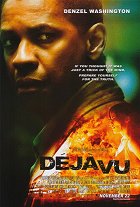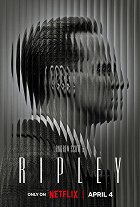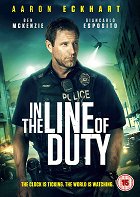Jännitys - Genret
Suosituin suoratoistopalveluissa tänään
Characteristics and sub-genres of the thriller
Thriller is a fictional genre that aims to build suspense and other related feelings such as anticipation, curiosity, surprise, excitement and anxiety, which can be achieved in many ways: placing the characters in dangerous situations and evoking a sense of threat, delaying something evil and inevitable, or gradually unravelling mysteries and secrets. The protagonists of thrillers often seek to save their own or someone else's life by solving problems and crisis situations or fulfilling some kind of mission. Frequent themes include chases and pursuits, plots and conspiracies, murder, revenge and hostage situations, assassins for hire, espionage and the concealment of important information, or the search for murderers, thieves, kidnappers, psychopaths and terrorists. Thrillers are usually fast-paced, often have unexpected plot twists, false leads, a certain amount of action, and reach their climax in the most suspenseful moments. By their very nature, they can easily blend with other genres, typically, for example, the crime genre, which, however, places much more emphasis on developing a criminal or detective plot, or the horror genre, which, however, is based more on evoking fear and terror than on mere suspense, and which, unlike the thriller, more often uses supernatural elements.
In addition to crime-thrillers and thrillers with horror elements, other common categories include spy thrillers, set in the world of secret services, and psychological thrillers that emphasize changes in human behaviour, human identity and the experience of complex mental processes. There are also legal and political thrillers that focus on lawyers and government officials and political motives, such as conflicts between powers, assassinations of statesmen, or uncovering corruption networks, and mystery thrillers that work with unreal and paranormal motives. In techno-thrillers, the plot usually revolves around the use of advanced technology; in conspiracy thrillers the uncovering of secret machinations plays a major role; erotic thrillers combine a suspenseful plot with more or less explicit nudity and sex scenes; and comedy thrillers mix suspense with humour. In addition to suspense, thrillers can also offer social commentary or critique, most often around social or racial issues. Action thrillers, sci-fi thrillers and disaster thrillers are also common, but these are described in the sections on sci-fi, action and disaster films, just as crime films are assigned their own genre category.
The birth of the thriller at the beginning of the sound era
The silent comedy Safety Last! (1923) is considered one of the first thrillers, with a protagonist, played by Harold Lloyd, who climbs a high-rise building without any safety net in an extremely thrilling stunt. Fritz Lang Spies (1928), a German film about the romance of two agents from rival secret services, was the first spy thriller to use a number of elements, such as secret organisations with hidden headquarters and the use of numbers to identify agents, which would influence the development of the genre for several decades to come. Lang later made, among others, the thriller Man Hunt (1941) in the USA, the hero of which was a British army captain pursued by the Gestapo after a failed assassination attempt on Adolf Hitler.
Director Roland West made the thriller The Bat Whispers (1930), a remake of his own 1926 silent film about the inhabitants of a large house terrorised by an unknown criminal, while in The Most Dangerous Game (1932), the main characters were confronted with a strange count who organized manhunts on his private island. The British thriller Rome Express (1932) dealt with a stolen painting, blackmail and murder on a moving train, and in Night Must Fall (1937) a handy farmhand is hired to work on a farm, but his presence raises questions about a series of murders that are occurring in the vicinity.
Zaroffin koirat (1932)
Kuva © RKO Radio Pictures
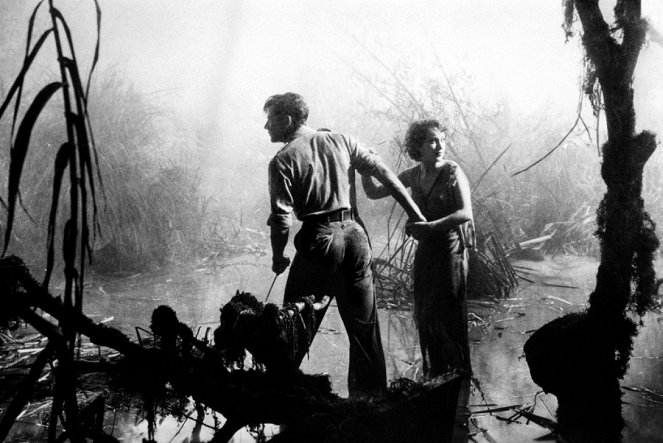
Alfred Hitchcock or the “Master of Tension”
British director and screenwriter Alfred Hitchcock started out as a writer of intertitles in silent films, but he would become a genre legend and one of the most famous filmmakers of all time, who gave the thriller a unique concept that influenced the development of the genre in the following decades. His silent film The Lodger (1927) was already a thriller, a search for the infamous Jack the Ripper in which Hitchcock first explored his favourite motif of the innocent woman in danger. His next thriller was the sound film Blackmail (1929), in which the main character kills an assailant in self-defence, and the murder is then investigated by her fiancé. He then went on to make the comedy conspiracy thriller The Man Who Knew Too Much (1934), which he remade himself in 1956, and would later direct The 39 Steps (1935), a film about a fugitive on the run, Sabotage (1936), about a police sergeant's search for a suspected terrorist, and Young and Innocent (1937), a thriller in which an innocent man suspected of murdering a famous actress searches on his own for the real killer. In the comedic conspiracy thriller The Lady Vanishes (1938), the cult director tells the story of the search for a passenger on a moving train who has disappeared during the journey.
In 1940, Alfred Hitchcock was invited to Hollywood to make Rebecca (1940), the story of a married couple, played by Laurence Olivier and Joan Fontaine, who after their wedding travel to the man's aristocratic estate, which terrifies his newlywed wife. It was an extraordinary success, taking in two of its eleven Oscar nominations (including Best Picture) and launching Hitchcock's long career in the US, where he would spend the rest of his life. That same year he premiered his American thriller Foreign Correspondent (1940), in which he combined the theme of World War II with an espionage plot involving an ordinary journalist who was in the wrong place at the wrong time. Hitchcock then directed Suspicion (1941), starring Joan Fontaine as a woman in love whose indebted boyfriend, played by Cary Grant, wants to kill her over her life insurance policy. His next thriller was Saboteur (1942), about an innocent bystander pilot who is drawn into a war crime and chased by both the police and criminals. In short succession he then made the psychological thrillers Shadow of a Doubt (1943) and Spellbound (1945), the spy-thriller Notorious (1946) and the conversational-thriller Rope (1948), which gave the illusion of a film shot in a single take.
But it was not until the 1950s that he made his most famous films, beginning with Stage Fright (1950), set in a theatre, and especially Strangers on a Train (1951), in which two men who meet by chance arrange the murders of two people they want to get rid of. After Dial M for Murder (1954), in which he combined an attempted, perfectly planned crime with its police investigation, Hitchcock made the four Oscar-nominated Rear Window (1954), starring James Stewart and Grace Kelly as a couple who, based on close observation, come to believe that one of their neighbours has killed his wife. The aforementioned The Man Who Knew Too Much (1956) was followed by Vertigo (1958), a dreamlike psychological tale of a former police officer who falls in love with a woman he has been secretly assigned to follow, and North by Northwest (1959), another masterful thriller, in which an advertising professional played by Cary Grant falls victim to Secret Service agents in a story that made cinematic history with a scene of a man being chased by a plane and its climax at the Mount Rushmore Monument. In the 1960s and 70s, after the famous horror films Psycho (1960) and The Birds (1963), Hitchcock went on to direct the thrillers Marnie (1964), Torn Curtain (1966) and Frenzy (1972), among others, but they did not enjoy the extraordinary success of his previous films.
Främlingar på tåg (1951)
Kuva © Warner Bros. Pictures
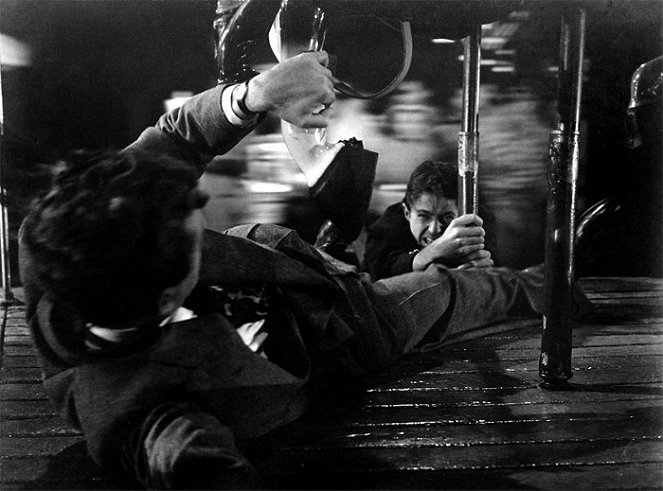
Other thriller filmmakers in the 1940s
In the USA, film noir reigned supreme in the 1940s, while classic thrillers, which were also made to a lesser extent, often used similar themes to some of Hitchcock's films, typically the pursuit by Secret Service agents or the predicament of a protagonist exposed to potential danger. The former theme was the premise, for example, of Carol Reed's war comedy thriller Night Train to Munich (1940), which had its heroes travel to various attractive European locations and cities as part of a spy plot, an element that would become popular in a number of later thrillers, especially those about secret agents visiting exotic locations around the world on their missions. Shortly after, in 1943, came the spy thrillers Journey into Fear, Above Suspicion and The Fallen Sparrow.
The premise of the second theme mentioned above was used by, among others, the British film Gaslight (1940) and its American version directed by George Cukor in 1944, a psychological thriller dealing with a woman's fears of losing her mind in the family mansion she and her husband take up residence in after the death of her aunt. Robert Siodmak's The Spiral Staircase (1945), about a young mute housewife hiding from a killer of physically disabled women, and Anatole Litvak's Sorry, Wrong Number (1948), in which the protagonist accidentally overhears a plan for her own murder on the telephone, worked with the motif of women confronted with the presence of a killer. Years later, Terence Young's Wait Until Dark (1967), starring Audrey Hepburn as a lone blind woman who is being threatened in her apartment by a group of thugs, was a major success.
Journey Into Fear (1943)
Kuva © 41. Letní filmová škola
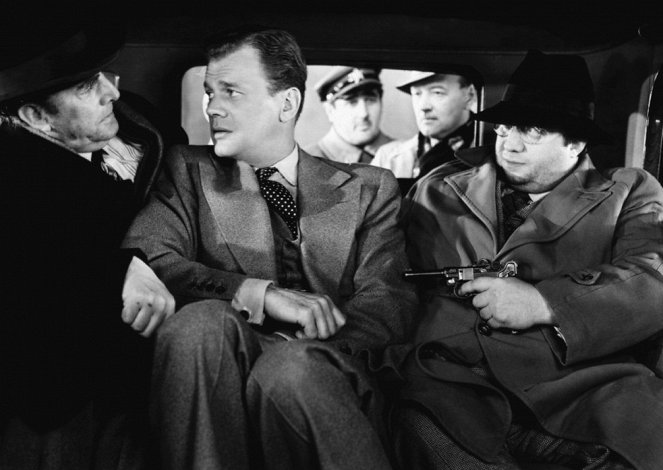
Political and spy thrillers of the 1950s and 60s
John Sturges’s Bad Day at Black Rock (1955) and Norman Jewison's In the Heat of the Night (1967) are considered two of the earliest social-critical thrillers, in which the main villain is figuratively society itself. The former is a Western-style story about a World War II veteran who encounters the suspicious reluctance of the locals when he tries to locate a Japanese farmer in a remote American town, while the latter dealt with racial issues in a crime-thriller about Southern police officers who are helped to investigate the death of a wealthy businessman by a black homicide specialist. In The Bad Seed (1956), the mother of a ten-year-old girl is convinced her daughter is a murderer; the main anti-hero of the British film Peeping Tom (1960) is a lonely photographer and voyeur obsessed with capturing the death of a murder victim on film; and in Cape Fear (1962), the protagonist is an ex-convict who decides to take revenge on the man who had convicted him of a crime years earlier.
Stanley Donen's Charade (1963), starring Cary Grant and Audrey Hepburn, combined a romantic comedy with a spy thriller, while the political thriller The Manchurian Candidate (1962) revived the theme of secret agents and government conspiracies in the 1960s. Some thrillers dealing with the US-Soviet conflict during the Cold War were also political, Sidney Lumet’s Fail-Safe (1964) and John Frankenheimer’s Seven Days in May (1964) are two examples. The British trilogy The Ipcress File (1965), Funeral in Berlin (1966) and Billion Dollar Brain (1967), starring Michael Caine, explored the world of the British Secret Service in an attempt to compete with the much more action-packed and adventurous Bond films of the time. Espionage was also the subject of the British films The Spy Who Came In from the Cold (1965), The Deadly Affair (1967) and The Quiller Memorandum (1966). Blow-Up (1966), directed by Italian modernist director Michelangelo Antonioni for the Western market, captured the atmosphere of the 1960s against the backdrop of the story of an hedonist photographer who may have accidentally photographed an attempted murder.
Hemliga agentens kartotek (1965)
Kuva © Carlotta Films

Conspiracy and other thrillers of the 1970s
By the early 1970s, thrillers were becoming more violent, thanks in part to the film franchise that began with Don Siegel's Dirty Harry (1971), starring Clint Eastwood as a cynical police officer tasked with catching a mysterious sniper, disregarding regulations and superiors in pursuit of his goals. Eastwood also made a name for himself as a director with the thriller Play Misty for Me (1971), in which he played the character of a radio DJ who falls victim to an obsessed fan. Charles Bronson succeeded as a self-proclaimed vigilante in Michael Winner’s Death Wish (1974), launching a series of action thrillers on the theme of civil self-defence. There was also plenty of on-screen violence in John Boorman's adventure thriller Deliverance (1972), whose heroes clash with a group of rugged hillbillies as they raft down a wild river in a tale that polemicises the morality of the struggle for survival. The thriller See No Evil (1971) added to the brutality, again dusting off the hackneyed theme of a woman in danger, this time with Mia Farrow as a blind woman hiding in a house from the man who murdered her family, while in Sam Peckinpah's Straw Dogs (1971), the main character, played by Dustin Hoffman, had to confront the group of men who raped his wife.
The Watergate affair in 1972, when staffers of then Republican President Richard Nixon's office were caught installing wiretaps at the Democratic Party headquarters, gave rise to a number of conspiracy and political thrillers, for example, Alan J. Pakula's The Parallax View (1974), a tale of political conspiracy that reflected the mood of American society after the assassination of President Kennedy in 1963 and during the Vietnam War. Pakula would deal directly with the Watergate affair in the four Oscar-winning All the President's Men (1976), which realistically outlined the behind-the-scenes of a newspaper newsroom and the complexities of editorial work, while depicting the story of a pair of investigative journalists, played by Dustin Hoffman and Robert Redford, who gradually uncover the government's hidden truth behind Nixon's scandal.
Other conspiracy thrillers included Sydney Pollack's Three Days of the Condor (1975), about a CIA agent's life in danger, and Peter Hyams's science fiction film Capricorn One (1977), in which the US government deceives the public with fake footage of a NASA space shuttle landing on Mars. Fred Zinnemann's British-French thriller The Day of the Jackal (1973), about a secret organisation that pays for the assassination of the French president, can also be described as a political thriller. The theme of wiretapping was explored in Francis Ford Coppola's The Conversation (1974), in which Gene Hackman plays an expert on phone bugs who unravels a web of secrets and murders while being wiretapped himself.
In the British thriller Sleuth (1972), starring Laurence Olivier and Michael Caine, a successful author of detective novels invites his wife's lover to his home with an elaborate revenge plan. In the mysterious psychological thriller Don't Look Now (1973), Julie Christie and Donald Sutherland, as a husband and wife, try to recover from the death of their daughter in a sinister Venice. Steven Spielberg's Jaws (1975) was a huge hit with the story about giant shark threatening the visitors to sunny a beach. The film won three Oscar, went on to inspire a number of other animal thrillers and horror films and spawned several sequels. Brian De Palma also enjoyed success with his thrillers Sisters (1972), Obsession (1976) and The Fury (1978).
Capricorn yksi (1977)
Kuva © Warner Bros. Pictures
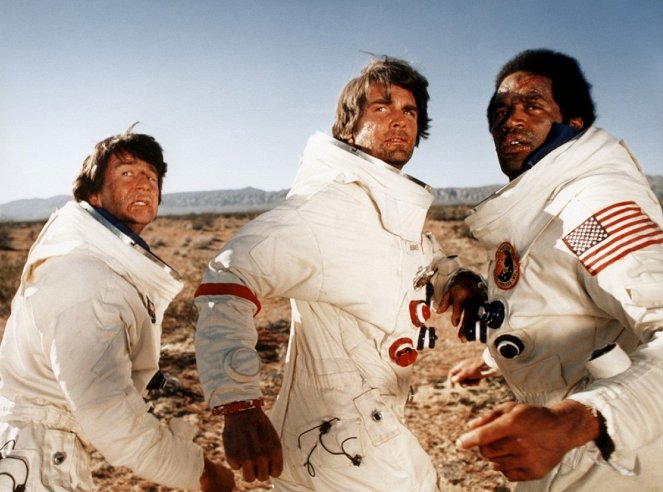
French and Italian thrillers of the 1950s to the 1970s
Among the European countries, France has a relatively long history with thrillers, with Henri-Georges Clouzot making films of this genre, especially in the 1950s. He had already made the crime-thriller The Murderer Lives at Number 21 in 1942 and followed it up a year later with the psychological film The Raven, in which he depicted the ordeal of a doctor victim of defamatory anonymous letters delivered to the people in his town. He then directed The Wages of Fear (1953), the story of truck drivers transporting a dangerous load of nitroglycerine through the Latin American jungle, which became the basis for a 1977 American remake directed by William Friedkin. His film Diabolique (1955), about the plot to murder a despotic school headmaster by his wife and her lover, would receive an American remake of the same name many years later, in 1996. In the 1960s and 70s, France produced a number of thrillers, for example, Greek director Costa-Gavras’s political film Z (1969), about the search for the truth in the murder of a Greek politician, was awarded an Oscar. Costa-Gavras would later direct, among others, the thrillers The Confession (1970), State of Siege (1972), Special Section (1975), and Missing (1982). However, at the time, thrillers were already on the decline in France in favour of the immensely popular crime films starring Alain Delon and Jean-Paul Belmondo.
Popular in Italy in the late 1960s and during the 1970s, the so-called Giallo films were characterised by explicit bloody murders, psychological themes of madness and paranoia, voyeurism, sexual themes, a strong musical soundtrack, a highly stylized visual design, a surrealistic atmosphere and unconventional pictorial compositions, often fetishistically focused on various objects or parts of the human body. They were usually psychological thrillers or psychological horror films with a detective or crime plot. The cornerstone of the genre was Mario Bava's thriller The Evil Eye (1963), whose heroine, a fan of detective stories, tries to convince those around her that she has witnessed a real murder. Bava would later reap success with Blood and Black Lace (1964), Lucio Fulci made, among others, Don’t Torture a Duckling (1972), Emilio Miraglia directed The Red Queen Kills Seven Times (1972), and horror director Dario Argento made a name for himself with films such as Deep Red (1975), Tenebrae (1982), and Sleepless (2001).
Z (1969)
Kuva © Valoria Films

American thrillers in the 1980s
In the 1980s, Brian De Palma made, among others, the thriller Blow Out (1981), in which he cast John Travolta in the lead role of a sound engineer who accidentally witnesses a strange car crash, and Canadian filmmaker David Cronenberg also settled in the thriller genre for a while, directing with Christopher Walken the mystery film The Dead Zone (1983) and then casting Jeremy Irons in the role of identical twins in Dead Ringers (1988). In Eyewitness (1981), William Hurt finds the corpse of an Asian businessman, which brings him closer to a TV reporter played by Sigourney Weaver. In the psychological thriller Still of the Night (1982), Roy Scheider stars as a psychiatrist who falls into an affair with a woman suspected of murder, played by Meryl Streep. Harrison Ford had starring roles in Peter Weir’s thriller Witness (1985), in which he plays a police officer tasked to protect a young boy who has witnessed a murder, and in Roman Polanski's Frantic (1988), in which he tries to rescue his wife, who has been kidnapped in the French capital.
Political thrillers include No Way Out (1987), starring Kevin Costner as a Pentagon employee trying to prove his innocence in the killing of the Secretary of Defense's mistress, and Criminal Law (1988), starring Gary Oldman and Kevin Bacon, an example of a legal thriller in which a skilled attorney decides to prove that his client is actually a murderer. David Lynch entered the psychological thriller genre with Blue Velvet (1986), which exposed a world of violence and sexual deviance behind the curtain of a quiet town. In Into the Night (1985), a comedy thriller by John Landis, the main characters played by Jeff Goldblum and Michelle Pfeiffer find their lives threatened in a plot about stolen emeralds. The fact that offering someone a helping hand can backfire badly was the subject of, for example, The Hitcher (1986), where an innocent young man is suspected of murders actually committed by the psychopathic hitchhiker he picked up, and in Dead Calm (1989), where a husband and wife played by Nicole Kidman and Sam Neill have to fight for their lives on a yacht on which they have picked up a dangerous castaway.
Blow Out - vittnet måste tystas (1981)
Kuva © Filmways Pictures

The rise of erotic thrillers in the 1980s and 90s
Although nudity had appeared sporadically in some thrillers, the erotic thriller as an standalone sub-genre was born in the 1980s, after the premiere of Brian De Palma's Dressed to Kill (1980) and Body Double (1984), Lawrence Kasdan's Body Heat (1981) and, in particular, after the success of Adrian Lyne's Fatal Attraction (1987). Lyne's film, starring Michael Douglas as a happily married lawyer and Glenn Close as the mistress who becomes obsessed with him, earned six Oscar nominations and became one of the highest-grossing films of that year. The subsequent boom of thrillers that enriched their plots with the love affairs of the main characters and the more or less subtly exposed bodies of their protagonists eventually caught on easily thanks to cable television and the videotape market. A number of erotic thrillers (some almost pornographic, in fact) were even made for direct-to-video distribution, including Night Eyes (1990), Last Call (1991) and Animal Instincts (1992).
The early 1990s saw the release of, among others, Poison Ivy (1992), Single White Female (1992) and Color of Night, with Bruce Willis and Jane March (1994). But the most important erotic thriller of this period was Paul Verhoeven's Basic Instinct (1992), starring Michael Douglas and Sharon Stone as a police detective and a writer suspected of murder who wraps him around her finger. Basic Instinct was a box-office hit and successfully introduced the lesbian theme into the erotic thriller genre, which was later also used in Wild Side (1995) and Bound (1996). Sharon Stone went on to star in the erotic thriller Sliver (1993), and Paul Verhoeven returned to directing nude scenes in Showgirls (1995), which portrayed the flip side of the show business. This was followed by William Friedkin's Jade (1995), Never Talk to Strangers, starring Rebecca De Mornay and Antonio Banderas (1995), and Stanley Kubrick's dreamy Eyes Wide Shut (1999), with Tom Cruise and Nicole Kidman in the leading roles of a married couple undergoing a sexual revival.
Basic Instinct - vaiston varassa (1992)
Kuva © TriStar Pictures
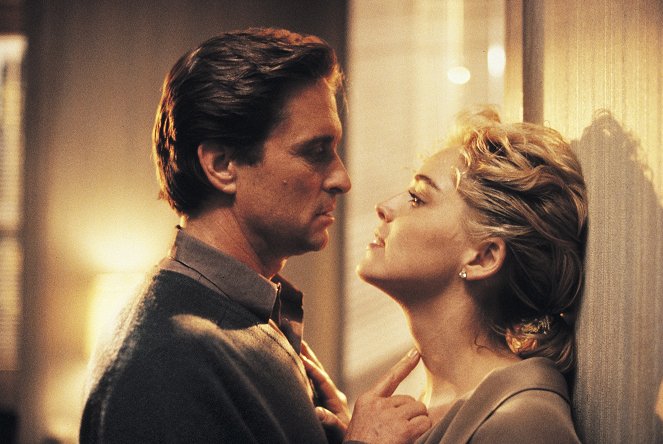
The rise of American thrillers in the 1990s
A number of thrillers in the 1990s used the motif of a kidnapper or persuasive manipulator and a plot scheme involving the attempts to release the victims from their captivity or influence. Examples of this premise include Rob Reiner's Misery (1990), about a popular writer forcibly kept prisoner by a tyrannical, obsessive fan, The Hand That Rocks the Cradle (1992), in which a family's peace is shattered by a vengeful nanny, Nick of Time (1995), in which the protagonist, played by Johnny Depp, must fight for his daughter's life against kidnappers demanding the he kills the governor of California, while Mel Gibson faced his son's kidnappers in Ron Howard's thriller Ransom (1996). In The Vanishing (1993), Kiefer Sutherland searches for the kidnappers of his missing fiancée, and Kurt Russell goes after his wife's kidnappers in the thriller Breakdown (1997). Jonathan Demme crime-thriller The Silence of the Lambs (1991) was extremely successful, taking in five of its seven Oscar nominations, including Best Picture, and starring Jodie Foster as an FBI agent searching for a serial killer who is forced to work with a cannibalistic psychiatrist played by Anthony Hopkins.
Conspiracy thrillers resurfaced in the 1990s in the form of Patriot Games (1992) and Clear and Present Danger (1994), both starring Harrison Ford as a fearless CIA agent. Ford also appeared in the lead roles of Alan J. Pakula's Presumed Innocent (1990) and Andrew Davis's The Fugitive (1993). Some of the political thrillers worth mentioning include Oliver Stone's JFK (1991), which dealt with the events behind the assassination of President Kennedy, Wolfgang Petersen's In the Line of Fire (1993), starring Clint Eastwood as a Secret Service agent who has to protect the president from assassination, Alan Pakula's The Pelican Brief (1993), which revolves around the discovery of the truth in the killing of two incorruptible judges, and Tony Scott's Enemy of the State (1998), starring Will Smith as the scapegoat in the murder of a congressman. There were also several legal thrillers, such as The Firm by Sydney Pollack (1993), in which a promising law graduate played Tom Cruise finds himself trapped by his employers at a law firm; Primal Fear by Gregory Hoblit (1996), starring Richard Gere as an attorney defending a schizophrenic suspected of murder played by Edward Norton; and Devil's Advocate by Taylor Hackford (1997), starring Keanu Reeves as a young lawyer and Al Pacino as his demonic employer.
Martin Scorsese directed Cape Fear (1991), a remake of the 1962 thriller of the same name, Bryan Singer directed Apt Pupil (1998), about a high school student who recognises his neighbour as a former Nazi criminal, Brian De Palma followed up his thriller work with Snake Eyes (1998), and Darren Aronofsky made his feature debut with Pi (1998), a thriller about a mathematician who finds himself in danger because of a program that can predict the value of the stock market. David Fincher enjoyed great success with the crime-thriller Se7en (1995), starring Brad Pitt and Morgan Freeman as investigators searching for a murderer who kills according to the seven deadly sins, and the paranoid thriller The Game (1997), in which Michael Douglas plays a millionaire banker who finds himself caught up in a web of intrigue that begins to complicate his life after receiving an unusual birthday present. Director M. Night Shyamalan made the extremely successful horror thriller The Sixth Sense (1999), which became famous for its surprising twist ending. Other popular films include The Insider (1999) directed by Michael Mann and Payback (1999), starring Mel Gibson as a vengeful gangster who was robbed by his accomplices.
Misstänkt för mord (1990)
Kuva © Warner Bros. Pictures
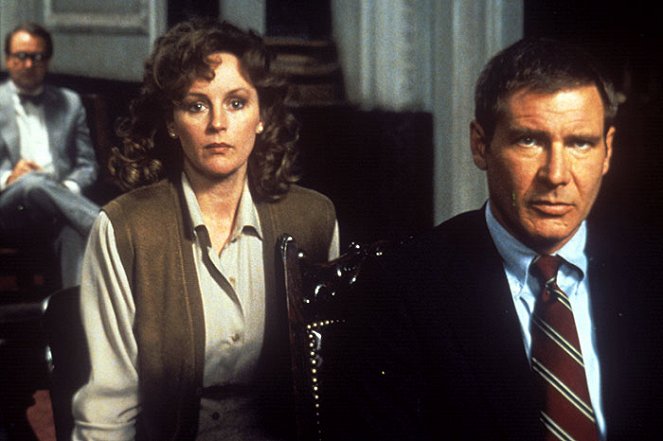
European thrillers from the early 1990s
In France, in 1990, Luc Besson made the action thriller Nikita, about a young drug addict who, after being arrested, joins a secret service, where she is trained to be a perfect agent and assassin. Besson then repeated his success with Léon: The Professional (1994), starring Jean Reno as a professional assassin. In Spain, Alejandro Amenábar made his first foray into the genre with his debut Thesis (1996), about a university student who finds herself in danger while writing a thesis on violence in the audiovisual industry. He would follow it with the successful Open Your Eyes (1997), which later received an American remake titled Vanilla Sky (2001). The Austrian thriller Funny Games (1997), about a family terrorized by a pair of young men, also got an American remake, and both versions were directed by Michael Haneke. British filmmaker Christopher Nolan directed the remake of the raw Norwegian thriller Insomnia (1997), about a pair of detectives whose murder investigation is complicated by the insomnia of one of them.
1994 saw the Danish thriller Nightwatch, about a night watchman in a morgue, and the mystery thriller Smilla's Sense of Snow (1997), a Danish-German-Swedish co-production about a promising scientist's search for the cause of a young boy's death. In Germany, director Tom Tykwer achieved international success with the thriller Run Lola Run (1998), in which he told the same story in several different versions, and a few years later with the co-production Perfume: The Story of a Murderer (2006), whose anti-hero is a fragrance connoisseur who produces the perfect perfume from the bodies of murdered young beauties. In Spain, Intact (2001) was a success with the story about a group of people with extraordinary luck experimenting with the limits of their gift, and the Hungarian mix of thriller and black comedy Kontroll (2003), about Budapest train inspectors searching for a man who pushes passengers under the train in subway stations, was also unprecedentedly popular. The British film Dirty Pretty Things (2002) can be described as a social thriller with a plot revolving around a found human heart, while also dealing with the plight of immigrants in the English capital.
In 2010, in a co-production between France, Germany and the UK, Roman Polanski made The Ghost Writer, a political thriller about a writer who becomes entangled in a web of intrigue while working on the memoirs of a former British Prime Minister. In Spain, the thriller Sleep Tight (2011) enjoyed success with its story about a psychopathic landlord who regularly makes nocturnal visits to his unsuspecting tenant, and so did Pedro Almodóvar’s The Skin I Live In (2011), starring Antonio Banderas as a plastic surgeon experimenting with a new skin type and gender reassignment, and the twist-packed The Invisible Guest (2016), about a businessman accused of murder who has to rely on the skills of his defence attorney.
The Nordic co-production Headhunters (2011) successfully combined suspense with black humour in a bloody tale of a talent scout and art thief who is after one of his victims, and did the same in In Order of Disappearance (2014), which dazzled with an entertaining revenge journey of a plow driver whose son was killed by mobsters, earning an American remake in called Cold Pursuit (2019). By contrast, Denmark's The Guilty (2018) thrilled audiences with a kidnapping plot seen from the perspective of a telephone operator. French films such as Double Lover (2017) and In the Shadow of Iris (2016) took the erotic thriller route, while Hungary's Jupiter's Moon (2017) combined the theme of the hunt for an illegal refugee with a sci-fi theme of supernatural abilities.
Tesis (1996)
Kuva © Las Producciones del Escorpión S.L.
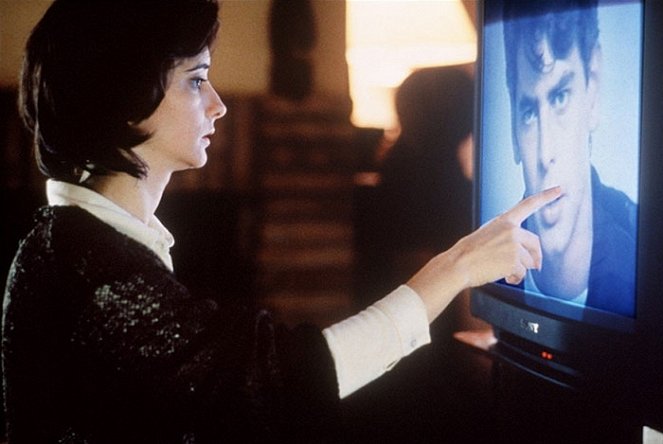
American thrillers after the turn of the millennium
Ridley Scott followed in the footsteps of The Silence of the Lambs with his sequel Hannibal (2001) and Brett Ratner did the same with Red Dragon (2002), but both failed to repeat the success of the original film. On the other hand, David Fincher successfully followed up his previous thriller ventures with Panic Room (2002), a film with Jodie Foster about a mother and daughter hiding from thieves in an impregnable secret room, M. Night Shyamalan, directed, among others, Unbreakable (2000) and The Village (2004), and Tony Scott directed the thrillers Spy Game (2001) and Man on Fire (2004), starring Denzel Washington as a former government agent on the trail of child kidnappers. The hero Jason Bourne, played by Matt Damon, also made a name for himself in the spy thriller genre, having searched for his identity in The Bourne Identity (2002), The Bourne Supremacy (2004), The Bourne Ultimatum (2007) and Jason Bourne (2016). Director Michael Mann shone with his thriller Collateral (2004), which cast Tom Cruise as an assassin, David Cronenberg made A History of Violence (2005), starring Viggo Mortensen as a father whose criminal past drives him away from his family, and Sydney Pollack returned to the political thriller with The Interpreter (2005), starring Nicole Kidman and Sean Penn.
Christopher Nolan made successful entries into the thriller genre with Memento (2000), a film narrated backwards, The Prestige (2006), an intricate story about the rivalry between two magicians, and Inception (2010), an eight Oscar-nominated sci-fi thriller about a group of dream infiltrators tasked with giving a sleeping man a specific idea. The co-production thriller The Machinist (2004), starring Christian Bale as a crippled man skinny from insomnia, and Hard Candy (2005), featuring Ellen Page as a teenage schoolgirl dealing with a paedophile photographer, both drew considerable attention. D.J. Caruso directed the thriller Disturbia (2007), starring Shia LaBeouf, and the techno-thriller Eagle Eye (2008), David Lynch lived up to his reputation with the mystery Mulholland Drive (2001) after his success with Lost Highway (1997), and James Mangold scored with Identity (2003), a thriller about a mysterious killer who gradually murders the inhabitants of a seedy motel.
Among political and legal thrillers, George Clooney's Syriana (2005) and Michael Clayton (2007) were prominent, while Ron Howard's The Da Vinci Code (2006), Angels & Demons (2009) and Inferno (2016), all starring Tom Hanks, became popular conspiracy thrillers full of mysterious symbols. Phone Booth (2002), a suspenseful drama starring Colin Farrell, played on one square metre, One Hour Photo with Robin Williams (2002) and Mr. Brooks with Kevin Costner and William Hurt (2007) joined the ranks of psychological thrillers, while the co-production The Constant Gardener with Ralph Fiennes and Rachel Weisz (2007) took a shot at pharmaceutical companies. The successors of the erotic thriller after the turn of the millennium include Killing Me Softly (2002), Unfaithful with Richard Gere and Diane Lane (2002), and In the Cut with Meg Ryan and Mark Ruffalo (2003). Later films in the same genre include Basic Instinct 2 (2006), Chloe (2009), Passion (2012), Knock Knock (2015) and Frank & Lola (2016).
History of Violence - tarina väkivallasta (2005)
Kuva © New Line Cinema
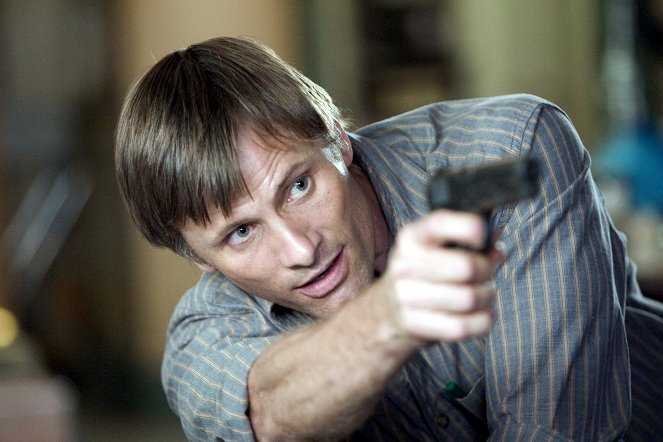
Thrillers from India and East Asia
Apart from America, thrillers have also thrived in India, in many cases abandoning the traditional elements of Bollywood cinema, taking inspiration from Western themes and filmmaking techniques, and also in some East Asian countries, where the genre has begun to become more prevalent, especially after 2000. South Korean filmmaker Chan-wook Park stirred the international cinematic waters with his revenge trilogy consisting of the thrillers Sympathy for Mr. Vengeance (2002), Oldboy (2003) and Lady Vengeance (2005), and some years later, he succeeded at festivals around the world with The Handmaiden (2016), a sensual thriller with lots of twists and intrigue that told the story of the relationship between a young noblewoman and her maid, set up by a marriage swindler.
An even bigger hit was the South Korean social thriller Parasite (2019), directed by Joon-ho Bong. It was the first non-English-language film in history to win the Oscar in the main Best Picture category and told the story of an impoverished family whose members fraudulently infiltrate the services of a wealthy businessman. Other South Korean thrillers that have been successful include the mystery Burning (2018), dealing with an unusual love triangle and several mysterious arson cases, and the spy thriller The Spy Gone North (2018), about the tense relations between South and North Korea. There have also been several erotic thrillers worth mention, such as The Scarlet Letter (2004) and Scarlet Innocence (2014).
Notable Indian films include Karthik Calling Karthik (2010), in which the protagonist's life is changed by a phone call from a man of the same name, the spy thrillers Once There Was a Tiger (2012) and Raazi (2018), in which the Indian protagonist marries a Pakistani officer for espionage purposes, and Raid (2018), about an incorruptible civil servant who becomes the target of a hostile rich politician. The thriller Story (2012), which combined a conspiracy plot about terrorist attacks in Calcutta with the story of a woman searching for her missing husband, was very successful, too. Visual (2013) was another major box-office hit, telling the story of an ordinary businessman who has to protect his family involved in the unintentional murder of the son of two policemen. It has since received four different remakes in India alone, the most famous of which was made in 2015. The thriller Neerja (2016), inspired by a real-life incident involving a hijacked plane and a courageous stewardess, also reaped success, and there have been some erotic thrillers that enjoyed popularity, such as the film series Jism (since 2003), Murder (since 2004) and Hate Story (since 2012), as well as Love Games (2016).
In Japan, in addition to live-action films, the thriller genre has seeped into anime, led in this respect by director Satoshi Kon, who was behind the mysterious psychological thrillers Perfect Blue (1997) and Paprika (2006). Among live-action films, we can highlight G@me (2003), about a brewery employee who impersonates the kidnapper of his boss's missing daughter, the thriller Kokuhaku (2010), whose heroine is a high school teacher seeking revenge, and another film about revenge called Grasshopper (2015), depicting the fate of a man who becomes involved with the underworld. Chinese productions include the mystery thriller The Great Hypnotist (2014), in which a sought-after psychologist is assigned to the case of a patient who can see ghosts, and Naneun jeunginida (2016), a remake of the South Korean film Beullaindeu (2011), about a former policewoman who has lost her sight and accidentally witnesses a crime. Hong Kong and China co-produced the thrillers Sleepwalker (2011), about two traumatised women and child abductions, and Bo fung yu (2014), in which a psychiatrist becomes increasingly uncertain about his decision to release a patient who had killed his wife three years earlier and decides to secretly treat him again.
Parasite (2019)
Kuva © CJ Entertainment

American thrillers after 2010
The psychological thriller Shutter Island (2010), directed by Martin Scorsese, received much praise from critics and audiences alike, with Leonardo DiCaprio as a detective searching for a missing female murderer who managed to escape from her cell in a psychiatric hospital located on an island. Equally praised was David Fincher's thriller Gone Girl (2014), in which Ben Affleck has to cope with the disappearance of his wife as the man suspected of her murder. With a strong social subtext, the horror-themed social thriller Get Out (2017) explored racial issues through the story of a conspiracy of white families who kidnapp young African Americans. Its creator, Jordan Peele, later made the social thriller Us (2019), which this time focused on the flip side of American society. Kathryn Bigelow's Detroit (2017), a film about the 1967 Detroit race riots, can also be considered a social thriller. The spy thrillers Hanna (2011) by Joe Wright, Tinker Taylor Soldier Spy (2011) by Tomas Alfredson, Bridge of Spies (2015) by Steven Spielberg, and Red Sparrow (2018) by Francis Lawrence have also left significant marks.
Liam Neeson starred in a number of thrillers directed by Jaume Collet-Serra: Unknown (2011), where he plays a scientist whose identity is usurped by a stranger, Non-Stop (2014), where he plays an air marshal who has to deal with an unknown terrorist on board a plane, and The Commuter (2018), where he takes the role of an insurance agent whose fate is in the hands of a dangerous secret organisation. The thriller film series The Purge (since 2013) has gained popularity, presenting an alternative version of an America where all criminal activity is regularly permitted for one night a year. Among legal thrillers, The Lincoln Lawyer (2011) received praise, starring Matthew McConaughey, while political thrillers included Oliver Stone's Snowden (2016) and Spielberg's The Post (2017), which dealt with the true story of journalists seeking to publish a secret report on the US government's involvement in the Vietnam War.
The thriller The Next Three Days (2010) starred Russell Crowe as a university professor trying to prove the innocence of his convicted wife and subsequently helping her escape from prison, while Hugh Jackman and Jake Gyllenhaal starred in Prisoners (2013), a film about the search for two girls. Gyllenhaal also shone in the psychological thriller Nightcrawler (2014), in which he took on the role of a freelance reporter shooting videos of crimes, police interventions and tragic accidents for television. Other psychological thrillers that stand out include Joel Edgerton's The Gift (2015), The Girl on the Train starring Emily Blunt (2016), and Fractured (2019), starring Sam Worthington as a husband and father of a missing mother and daughter trying to uncover a pharmaceutical conspiracy. Don't Breathe (2016) jangled audiences’ nerves with the story of a group of thieves who severely underestimate the abilities of their blind victim, while the mystery Under the Silver Lake (2018) subverted their expectations with a surreal search for a missing woman, and the horror thriller The Invisible Man (2020) effectively spooked them using the famous sci-fi motif in a story about a woman fleeing a relationship with an abusive husband.
Nightcrawler (2014)
Kuva © Open Road Films
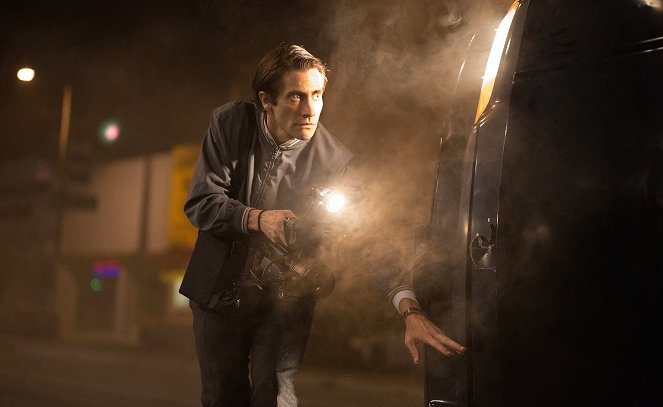
Thriller television series across the ages
Television screens have always been filled with crime and crime-thrillers series much more often than classic thrillers and their other sub-genres, but there are a few notable representatives of the genre in the history of series production. In the 1950s, these took the form of the anthology series Alfred Hitchcock Presents (1955-1962) and The Twilight Zone (1959-1964), each of whose episodes had a different story, most often falling into thriller, crime, horror, and science fiction. In the 1960s, The Alfred Hitchcock Hour (1962-1965) and Thriller (1960), which was followed by a series of the same name in 1973, had the same structure. Also popular were Tales of the Unexpected (1979-1988) and, in the 1980s, the more recent Alfred Hitchcock Presents (1985-1989), based on the 1950s show of the same name. Other series stuck mainly to the theme of spies and secret agents, the most notable of which include The Man from U.N.C.L.E.(1964-1968), and I Spy (1965), and the British The Avengers (1961-1969), Danger Man (1960), Tinker, Taylor, Soldier, Spy (1979), and Smiley´s People (1982).
The 1990s series The X-Files (1993-2018) was at the intersection of thriller, crime and mystery science fiction, featuring a pair of FBI agents played by Gillian Anderson and David Duchovny who investigate cases that are often shrouded in something mysterious or paranormal. The series 24 (2001-2010) was revolutionary, with all the episodes taking place in real time and the protagonist, a counter-terrorist agent played by Kiefer Sutherland, always had only one day to resolve a complicated situation and save his loved ones. Lost (2004-2010) became a phenomenon, depicting the adventurous lives of people who ended up as castaways on a mysterious island after a plane crash, and Prison Break (2005-2017) followed the actions of a man who goes to prison to help his wrongfully convicted brother escape. Series that have worked with the spy genre include, among others, Spooks (2002-2011), about the activities of a secret organization protecting Great Britain, and Alias (2001-2006), telling the story of a double secret agent. The category of political thrillers included Scandal (2012-2018), Designated Survivor (2016-2019) and Bodyguard (2018), whose protagonist is tasked with protecting a female politician who stands for everything he has ever despised in his life, while Homeland (2011-2020) told the story of a soldier who, on his return to his country after eight years of captivity in Iraq, is deemed a terrorist by a fanatical CIA agent.
Filmmaniak
Parhaat jännityselokuvat
Seitsemän (1995) |
Terminator 2 - Domens dag (1991) |
Yön ritari (2008) |
När lammen tystnar (1991) |
Med dödlig påföljd (1988) |
Aliens (1986) |
Leon (1994) |
L.A. konfidentiellt (1997) |
Inception (2010) |
Kuudes aisti (1999) |
| Kaikki parhaat jännityselokuvat |
